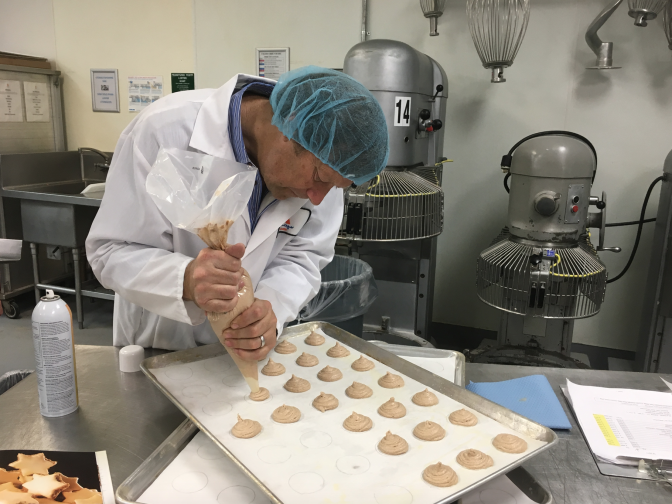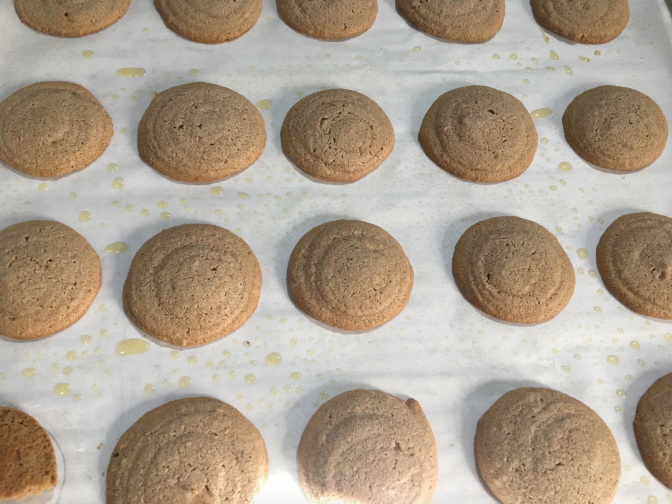Truth matters. Community matters. Your support makes both possible. LAist is one of the few places where news remains independent and free from political and corporate influence. Stand up for truth and for LAist. Make your year-end tax-deductible gift now.
This archival content was originally written for and published on KPCC.org. Keep in mind that links and images may no longer work — and references may be outdated.
National Pfeffernusse Day? The story of a holiday cookie
It's the week before Christmas, and Hans Rockenwagner's bakery in mid-city Los Angeles is humming.
Giant side-by-side mixers beat egg white and sugar, along with a mix containing almond paste and honey. They're just some of the ingredients that go into making the spice-laden cookie known as the pfeffernusse.
"We have ... candied citrus fruit, we have flour, baking powder, cocoa powder, and proprietary spice mixture," said Rockenwagner, a German immigrant and the owner of Rockenwagner Bakery.
The spices include a generous pinch of black pepper, which Rockenwagner folds into the mix.
"Pfeffernusse, it's pepper and nuts - pepper nuts," he said. "That is the literal translation."
The small, round spice cookies are popular in Germany and parts of northern Europe. But in the U.S., the pfeffernusse has enough fans to have its own food holiday: Dec. 23, otherwise known as National Pfeffernusse Day.
It's not clear just how the pfeffernusse got its own holiday. But it most likely hitched a ride across the Atlantic centuries ago, said Walter Staib, a chef and culinary historian based in Philadelphia who hosts a history-themed cooking show.
"It would have been the Amish, it would have been the Mennonites," said Staib, a German immigrant himself, referring to the early German-speaking settlers who were coming to the American colonies as early as the 17th century.
"People travel, they leave their countries, and they bring something along with them," he said. "And a tradition like pfeffernusse is an easy tradition that you can bring along with you. You don't have to go through a lot of hoopla to maintain your roots."
Staib said those early settlers brought with them Christmas traditions like pfeffernusse and stollen, a dried fruit bread, and continued to make them here.
The pfeffernusse cookies eaten in the U.S. aren't too different from the ones his grandmother made when he was growing up in Germany's Black Forest region, he said.
"We celebrated St. Nicholas Day on December 6," Staib said. "And what happens as a child is you put your shoes outside your bedroom, or your living room, or wherever ... and Saint Nick comes and gives you presents. And pfeffernusse is one of the things [you would get] if you were good. If you were not good, you maybe would find yourself with coals in your shoes."
From then on, he said, there would be pfeffernusse around to eat throughout the holidays.
Food blogger John-Bryan Hopkins, who chronicles food holidays on his Foodimentary blog and has even coined a few of his own, said he has found references to National Pfeffernusse Day dating as far back as 1963, in a women's magazine.
He says this is how many food holidays likely got their start.
"A lot of ladies' magazines were around that created food holidays," Hopkins said. "That's where a lot of these holidays came from, not actually from the people that make these foods."
Back at the bakery, Rockenwagner said he didn’t know there's a National Pfeffernusse Day. But no matter. He still plans to sell thousands of the cookies over the holidays, along with all manner of German holiday baked treats like stollen and lebkuchen, the pfeffernusse's larger, softer gingerbread cousin.
Some of the treats will be sold to cafes and stores, he said, and also at his Culver City cafe bakery, where he has a regular clientele of German expatriates.
"We do the holidays right," said Rockenwagner, who grew up in Germany and has lived in the U.S. for 30 years. "No one does the holidays like the Germans. It's the Super Bowl of holidays."












